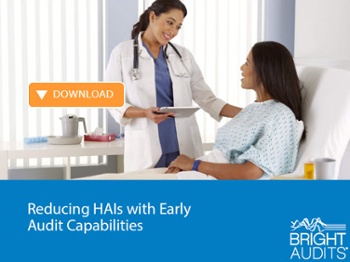Healthcare-associated infections (HAIs) are a growing concern for patients, impacting patient health and outcomes. Amidst a changing regulatory framework, HAIs also influence healthcare costs. For one, HAIs are considered preventable and therefore are subject to non-payment by insurers.
Although industry reports show progress in prevention, approximately one in 25 hospitalized patients acquire a HAI, posing a tremendous threat to patient safety. The good news is that the positive impact of prevention can be significant. The Centers for Disease Control and Prevention (CDC) reports that “rates of some targeted HAIs can decrease by more than 70 percent” with effective steps, such as auditing, to prevent them.

Healthcare executives and staff are all too familiar with HAIs. However, the facts are compelling. Baseline survey data from nearly a decade ago predicted annual HAI rates around 1.7 million, with 99,000 associated deaths. The results of the CDC’s 2014 HAI Prevalence Survey Progress Report, reflected an estimated 722,000 cases of infection in U.S. acute care hospitals alone.
Nearly 75,000 of these patients died while they were still admitted to the hospital. The infections contracted by hospital patients lead to extended hospital stays and readmissions, as well as creating a serious safety risk through unintended injury, disability and death. The corresponding financial burden on the healthcare industry is assessed at a staggering $28 to $33 billion annually. From a safety, risk and cost perspective, the ongoing implementation of preventive measures is a must.
Prevention of HAIs can be challenging for hospital staff that are already inundated by growing patient censuses, migration to patient-centric care and increasing regulation. A key in overcoming this obstacle is to ensure compliance and adoption of best practices, such as hand hygiene and safety training.
Additionally, with increased attention on HAI data collection and measurable outcomes, an approach that assists in reducing infection, as well as the burden of cost, can make a profound difference. In this environment, hospitals can no longer function without a comprehensive audit solution.
Auditing meets this criterion by providing early detection of associated risks and promoting continuous improvement. As described in a recent Becker’s Hospital CFO Article, “successful audit management means effectively capitalizing on all of the useful data gathered as a part of the audit process, and then using this information to boost revenue retention and proactively improve patient care.”
In other words, an auditing solution will help gain insight into HAIs and their prevention by providing reliable data about occurrences, causes of infection and the preventability of adverse occurrences.
For hospitals that want to reduce the prevalence of HAIs, working without audit controls in place is simply not an option. CLARIFIRE offers a real-time mobile auditing solution that is also a workflow platform, providing negative incidence triggers, real time alerts and escalations that help to standardize best practices across the hospital system.
As data reporting criteria continues to expand, CLARIFIRE also generates data that is “actionable” and readily translates into executive visibility. In a recent hospital network survey conducted by a CLARIFIRE audit client, their largest facility reported an HAI count that dropped from 21 to six, which is a 71 percent improvement! Manage your healthcare compliance and infection prevention efforts with CLARIFIRE.
We encourage you to take a few minutes to learn how CLARIFIRE can help you track and prevent HAIs through innovative technology. Visit us at eClarifire.com, or contact us directly at 727.507.3440.
Let us show you why CLARIFIRE truly is BRIGHTER AUTOMATION®.
Lauren Walling
Lauren Walling is a graduate of Emory University with a degree in Industrial Psychology, as well as an MBA from the John Sykes School of Business from The University of Tampa. She currently sits on the Board of Fellows at the University of Tampa, and is a member of the Healthcare Business Women's Association, National Association of Professional Women, and the Morton Plant Skip Cline Society. Lauren works with large Healthcare Systems implementing Patient Experience Solutions that streamline processes, increase patient experience and improve quality and safety.



